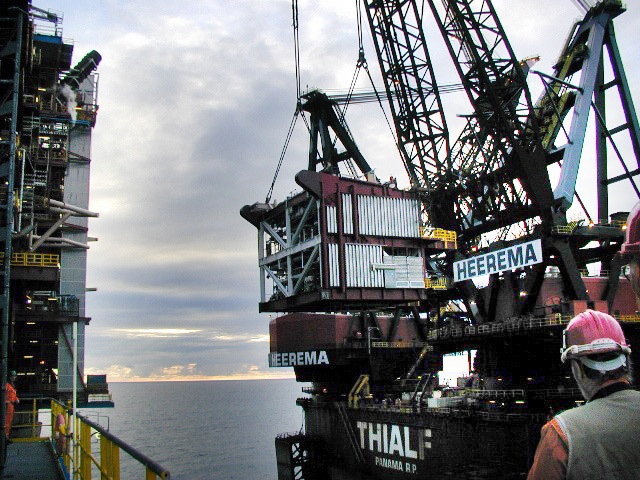
Despite the current UK Continental Shelf new projects boom, together with a significant number of life-extension projects under way, in the pipeline or being contemplated, momentum is gathering pace on the decommissioning front.
The most recent Oil & Gas UK Economic Report (2013) points out that, from 2013 through to 2040, £31.5billion is forecast to be spent on decommissioning existing assets, with new investment in probable developments adding £3.5billion to this total.
Zooming in, data gathered by OGUK for its brand new Decommissioning Insight published in time for Decom North Sea’s conference of October 3-4 reveals that operators are collectively planning some £10.4billion worth of infrastructure removals over the next ten years (2013-2022).
The numbers are enormous at every level.
Almost 340,000 tonnes of infrastructure earmarked for removal from the Central and Northern North Sea over the period 2013-22.
This includes over 230 topsides modules (270,000 tonnes), about 53,000t of substructure, more than 9,000t of what is classed as “other subsea infrastructure” such as manifolds and subsea isolation valves (SSIV), plus more than 7,000 tonnes of protective “mattresses”.
In the Southern North Sea and Irish Sea, the forecast is for removal of 75,000t of topsides, 46,000t of substructure and nearly 3,000 tonnes of subsea infrastructure. A further 6,000 tonnes of mattresses will also be removed.
The average topside module in the southern North Sea and Irish Sea weighs approximately 1,000 tonnes and costs just over £3,600 per tonne to remove.
In the Southern North Sea, platforms are commonly removed in one piece and in the 2013 survey it looks as if 2020 will turn out to be a particularly busy year with almost 40,000 tonnes of topsides and substructures expected to be removed in 2020 alone.
The report points out that this peak relates to less than 10 individual projects; a project presumably meaning a field. However, many SNS gasfields have multiple platforms, hence the high tonnage forecast to come ashore that year.
Oil & Gas UK says in its just published decommissioning insight report that the significant volumes of topside material to be removed will require a variety of removal methods to be employed and, depending on the integrity of the asset, significant engineering may be required.
As substructure removal peaks between 2016 and 2018, a large demand for heavy-lift vessels is expected. This more or less coincides with the arrival and settling in of a ship that will sail straight into the Guinness Book of Records . . . the Pieter Schelte which is currently being built by Daewoo of South Korea for the Dutch contractor Allseas.
Quite how this vessel’s arrival will affect the market is not yet clear and the OGUK report does not touch such specifics. However, it is likely to be profound, especially as Allseas holds the contract for all platform-related removals from the Brent field.
Edward Heerema, founder of Allseas told an audience at Offshore Europe that he expected this vast ship to be capable of uplifting a platform topsides (medium through large) per month in season, but that it would leave scope for other heavy lifters to secure decommissioning market share.
Basically, this means the Thialf with a twin crane (tandem) lift of 14,200t, Saipem 7000 (14,000 tandem), Svanen (8.700t), Hermod (8,100t tandem), Lan Jing (7,500t) and Balder (6,950t tandem).
Heerema did not say how long a North Season might be; Energy presumes it to be six to eight months.
It should be borne in mind that heavy lifters are in strong demand globally, both for heavy lift and, for some, pipelay operations. The Pieter Schelte will be similarly equipped.
OGUK does point out, however, that each removal method has its own “individual merits and project compatibility”.
“If decommissioning activity is to rise as forecast, this offers opportunities and challenges for the supply chain to expand lift capacity. For example, new single-lift vessels with considerable lift capacity are due to enter the market,” says the report.
Energy presumes the report’s author is referring to the likes of the Seven Borealis commissioned last year and which has a 5,000t capacity main crane; the just-christened Heerema ship Aegir with its 4,000t capacity crane and the Pieter Schelte referred to above and which is due for completion next year.
This monster will be able to take out entire platform topsides up to 48,000 tonnes in weight and jackets to 25,000t. Its build can be followed on the Allseas website, although pictures are of poor quality.
And its potential UKCS diet depending on contract wins.
Based on OSPAR data that the topsides shop window would appear to comprise: 13 topsides of 7,500-10,000t; 16 of 10,000-15,000t; 10 of 15,000-20,000t and 16 of 20,000-42,000t.
Dutch crane and pipelay systems designer and builder Huisman has a 7,000t “mast” crane under development.
To date, the largest single lift achieved on the UKCS during decommissioning using a heavy lift vessel was for the removal of the Frigg TCP2 module support frame at 8,500t.
Some heavy lift vessels are equipped with tandem cranes allowing a total crane capacity in excess of 14,000t, though as the report points out, removal is ultimately dictated by the geometry of the lift and integrity of the installation, which means multiple lifts have so far often been required.
The report says: “Data on the limited number of platforms successfully decommissioned up until 2011 reveals that the majority of topside weight lifted has been restricted to below 5,000t.
“Almost a third of topside weight removed was less than 500t and two thirds of substructure removal has occurred in the Southern North Sea.
“Forecasts would therefore suggest that the supply chain will need to become accustomed to the removal of larger weights and volumes as decommissioning activity increases.”
Turning to pipelines, OGUK says that, in the Central and Northern North Sea, over the ten-year period, nearly 40 trunk lines (130km), 115 “other pipelines” (420km), 87 umbilicals (250km) and almost 900 mattresses have been identified for decommissioning, with “significant expenditure from 2019 to 2022”.
“These forecasts would suggest that pipeline decommissioning will occur towards the latter end of decommissioning programmes.
“The peak in 2019 can be attributed to at least 10 pipeline decommissioning projects.”
Despite having a similar number of pipelines as the Southern North Sea, the decommissioning of “other pipelines” in the deeper Central and Northern North Sea is deemed to be considerably more expensive.
“This would suggest that more complex work is required to decommission pipelines in this area,” says the report.
And dead wells?
Again the numbers are impressive with more than 800 scheduled for decommissioning over the next decade, representing 16% of approximately 5,000 wells that will need plugging and abandoning in UK waters based on the current inventory.
At a cost of £4.5billion, wells P&A is the largest component (43%) of decommissioning expenditure on the UKCS over the next ten years.
FACTFILE
- Total forecast expenditure on decommissioning from 2013 to 2022 is £10.4billion of which 44% will be made in the Northern North Sea (NNS).
- Over 2,300km of pipeline, infrastructure from 74 fields, more than 70 subsea projects and over 130 installations are scheduled for decommissioning over the next decade.
- Wells plugging and abandonment is the largest category of expenditure totalling £4.5billion. This represents 43% of the total forecast decommissioning expenditure from2013 to 2022.
- More than 800 wells are scheduled for plugging and abandonment in this timeframe. Nearly 480 of these wells are in the Central and Northern North Sea (CNS & NNS) of which almost 60% are platform wells.
- In the CNS & NNS, the average forecast for wells plugging and abandonment expenditure is £4.8million per platform well, £10.1million per subsea development well and £8million per subsea exploration and appraisal well.
- In the SNS and Irish Sea, the average forecast for wells plugging and abandonment is £3.5million per platform well and £6.6million per subsea well.
- Removal of topsides, substructure and subsea infrastructure totals 21% of the overall decommissioning expenditure at £2.2billion. Nearly 470,000t of material are expected to be removed between 2013 and 2022.
- In the CNS & NNS, the average forecast expenditure of removing topsides is £4,100 per tonne and for substructures (jackets) £4,300 per tonne. In the SNS and Irish Sea, the forecasts average £3,600 and £5,700 for topsides and substructures, respectively.
- Some 11% (nearly £1.2billion) of the total is forecast to be spent on facilities running and owners’ costs. Assets need to be well maintained for a prolonged period to enable effective decommissioning.
- Over 405,000t of material are expected to be transported onshore for dismantling and processing between 2013 and 2022, with demand for UK disposal yards peaking in 2018 when over 80,000 tonnes of material are forecast to come onshore from the CNS and NNS.
- Decommissioning expertise is considered to be available within the UK supply chain, but without significant activity in this area the supply chain has not been fully tested. It is expected that some adjustment will be required as activity increases and competition for resources may be experienced.
Recommended for you

